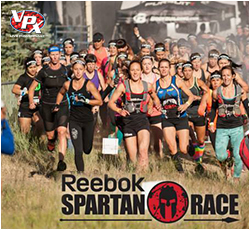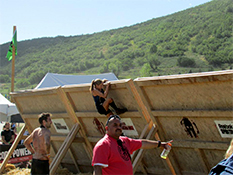The Bonk. Most runners have experienced it: that moment mid race, where your body feels like it hit a wall and you just.want.to.stop.
Or puke.
Or find a lounger and have an umbrella drink.
Runners World describes the Bonk or "hitting the wall" as, “the dreaded point (and awful feeling similar to what your body would feel like if you ran into a wall) during a race when your muscle glycogen stores become depleted and a feeling of fatigue engulfs you.”1
There have been lots of articles about the infamous Bonk, usually with runners hitting this wall during marathon-length or longer events. However, since even five-mile obstacle events can take three hours or more, Obstacle Racers face unique challenges when it comes to avoiding the Bonk. Here’s what I learned along the Utah trails:
For me, it came mile nine, while traversing the dusty trails at Soldier’s Hollow in Midway Utah during the Spartan Beast, a 12 mile, 24+ obstacle race.
Until that moment, I was feeling pretty good, excellent actually, considering the day before I had caught a one-day stomach bug my six-year-old had passed to me. 24-hours, 30 Pepto Bismols and half a jar of Tums later my stomach felt normal at the Start Line (antacids are performance enhancers, right?), and I had been hydrating, hydrating, hydrating all week.
This was my third year running this race and in the past the water stations had sufficed, so I had decided to race with nothing other than my normal gummies and gels stuffed strategically along my body.
 photo by John Becker
photo by John BeckerThe race started with a mile going straight UP and all was good! Add some steep downhills, 6 foot walls, concrete pulls and carries, crawls, rope climbs and even 60 penalty burpees… still trucking along.
But this course was living up to its Beast title and had changed a bit from year’s past, with two extra miles, more hills and added obstacles.
After the bucket carry, a concrete hoist and drag and going down and over a set of mud hills, I started wishing there were more water stations. It seemed as though my gummies were hardening, turning into chalk and making me want to gag. I spit one out, leaving a neon blob of orange on the side of the trail.
Ugh, queasiness.
Seriously?! Another switchback?
Um, this is mile 9, not 10?
When did my feet become bricks?
I felt sick – light headed, stomach bubbly -- and I pondered the pros and cons of stopping.
 photo by Marlene Bowden
photo by Marlene BowdenIt lasted only a few minutes before I finally realized what was happening. as if ripping off a Halloween mask, I suddenly recognized: The Bonk! And it was chasing me.
With only a few miles left, I scarfed down nearly all of my remaining gels, choked down a few chomps and took a few extra moments at the water stations to refill.
My feet kept moving and I made my way to the spectator area for some more obstacles. The inverted and traverse wall went by in a blur, “Don’t fall and don’t hurl,” I willed my body.
As I jumped off the wall, the battle was starting to subside. A few more switchbacks and while I didn’t feel as though the hills were alive with the sound of music, I knew I would finish, even starting to run faster. Crawling through one of the muckiest, muddiest and sloppy barbed wire crawls I’ve ever experienced, I swished my way up the (very,very) slippery wall and heard my family cheering for me.
The Bonk never did stop its pursuit, but it didn’t prevail either. I happily jumped over the fire finish!
This race was one of my favorites so far this year. I race for many reasons, but one of them is discovering more about myself and overcoming both physical and mental challenges, even when it’s uncomfortable. While I thought I had my nutrition needs dialed in, I also learned more about what my body needs.
Watch out Bonk, I’ll be even harder to catch next time!
Obstacle Racers Can Avoid The Bonk by…
-
Remembering that when you run an obstacle race, you will likely burn far more calories than in other kinds of athletic events. Eat at least every 15 minutes, whether you “feel” like it or not, and even more often if there are lots of strenuous stretches of terrain or challenges.
-
Bringing liquid nutrition, even if you prefer solid or gummies, just in case a water station is missing, chewing is difficult or you need to swallow while completing a challenge.
-
Taking advantage of any obstacle-free sections to hydrate and add calories.
-
Preparing for the Unexpected. I ran the same race in year’s past and had trained with the same number of miles, using the same nutrition with no “bonky” effects, yet this particular race was filled with more obstacles, not to mention I ended up doing two sets of 30 penalty burpees and fought off a stomach bug the day before. Train with the nutrition you expect to use, then add more just in case.
-
Carrying Water to Longer Races. Most gels/chomps/Gus take at least 15 minutes to digest and work best with liquids. The only way to be sure you can maintain the nutrition you need, is by carrying hydration with you. Even though I typically run this distance in training without a pack, I will plan to bring one from now on.
-
Know that when you start to feel bonky symptoms you may be too late. Do what you can to safely hydrate and add calories, but mentally brace yourself for a rough ride or the possibility you might need to stop.
-
Reflecting after an event on your race nutrition. How did you feel? What was working – or not – and why? Each event is different, but a “recipe” for success gets easier the more you know your body and how it reacts to different factors (number of obstacles, difficulty of obstacles, type of obstacles, race length, the weather, body fatigue/sickness, etc).
Have you ever experienced the bonk? Share your story & race tips in the comment below.
 This is a guest post by Leslie St. Louis, a competitive obstacle racer. Leslie is a mountain-loving trail lover and mom of two mud-loving girls in Morrison, Colorado. She is also ranked 9th in the Spartan World Points Series and the founder of a local obstacle group and resource, Colorado Obstacle Racers. She is proud to be a part of VPX Team Xtreme, as well as a member of the Spartan Pro Team and All Pro CrossFit Community.
This is a guest post by Leslie St. Louis, a competitive obstacle racer. Leslie is a mountain-loving trail lover and mom of two mud-loving girls in Morrison, Colorado. She is also ranked 9th in the Spartan World Points Series and the founder of a local obstacle group and resource, Colorado Obstacle Racers. She is proud to be a part of VPX Team Xtreme, as well as a member of the Spartan Pro Team and All Pro CrossFit Community.
1Moxey, Beth, and Parker Morse. "Glossary of Running Terms." Runner's World & Running Times. Web. 22 Aug. 2014. <http://www.runnersworld.com/running-tips/glossary>.







